Mealtime Partners, Inc.
Specializing in Assistive Dining and Drinking Equipment
May 2017 Independent Eating and Drinking Newsletter

|
May Topics:
|
||
|
Mealtime Partners Home Page Send a Comment or Suggestion |
|||
| Subscribe to Newsletters |
How to Attach Accessories to Wheelchairs and Beds
Mealtime Partners began as a research company that studied the effectiveness of powered dining equipment. As a result of the research findings, the Assistive Dining Device was developed and was later refined into the current Mealtime Partner dining system. However, as we worked with individuals who cannot feed themselves, the company recognized that there was also a need for drinking systems that could be accessed without the use of hands. At the time we started developing drinking systems, all wheelchairs, whether they were powered or manual, had tubular or square metal frames, and handles. This made clamping to wheelchairs quite straight forward. We used our Wheelchair Clamp (Figure 1) for attaching all of our drinking systems to any brand of wheelchair. Similarly, hospital bed rails were tubular metal and the same clamp could be used to attach drinking systems to a bed.
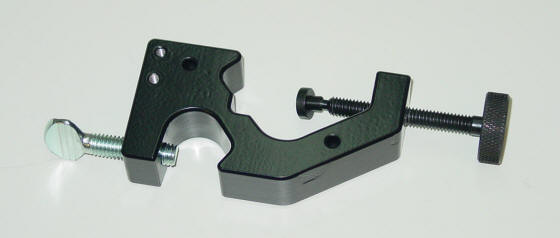
|
| Figure 1: The Wheelchair Clamp (Part No. 4960) |
| The opening on the right attaches to a wheelchair or bed, and the opening on the left holds the drinking system. |
Over time, wheelchair and hospital bed designs have evolved. Many hospital beds now have plastic bed rails that have electronic controls integrated into them (as shown in Figure 2, below). The patient or hospital staff can raise and lower the bed head or foot using buttons that are part of the bed rail, as well as perform other functions (depending upon the make and model of the bed). This new bed rail design prohibited our original wheelchair clamp from firmly attaching to the rail as the plastic gives under the pressure of the clamp, allowing the clamp to loosen and alter its position over time. To address the problem created by the new bed rail design and to continue satisfying the need to provide hands-free hydration to people who are in hospital beds, Mealtime Partners developed the Hospital Bed Clamp (also shown in Figure 2). This clamp holds firmly on plastic bed rails because it distributes the required holding pressure over a large area of the plastic rails. The top and bottom portions of the clamp fit between the openings in the bed rail. Once it is installed, the Hospital Bed Clamp maintains its position, indefinitely.
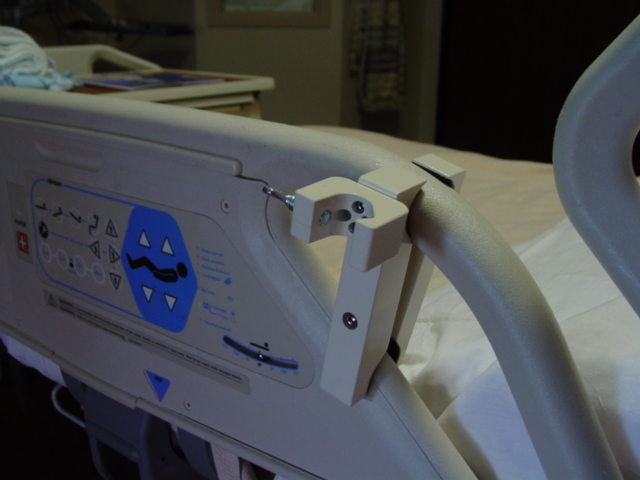
|
| Figure 2: The Hospital Bed Clamp (Part No. 4980) |
Many of the more recently manufactured wheelchairs do not have tubular frames as part of their structure. They are made up of a base unit that holds the wheels, motors, batteries and electronics, and a seating system that is added to the base. The seating systems are customized to meet the needs of each individual even though they are made up of standard components. To efficiently integrate all of the components needed by each individual, many wheelchair manufacturers designed rails that have tracks (i.e., slots) in them where accessories can be attached. (A T-shaped nut is inserted into the slot and components can be screwed into the threaded hole in the nut.)
These rails are installed at various locations on a wheelchair seating system. Common locations are along the edges of the seat base, on the seat back, and under the armrests. Seating components that are mounted on the tracks include armrests, head rests, lateral supports, and joysticks and their associated drive controls. The great value of this method of developing a seating system is that all of the components that make up the seating system can be positioned exactly where they are needed for each individual. For example, the arm rests do not necessarily need to be positioned parallel to each other. For someone who has skeletal anomalies it might be more appropriate for the armrests to be staggered. Thus a wheelchair can now be unique to its user and yet be made up of an assortment of standard parts.
Permobil chose to use a rail that has two tracks. All other wheelchair manufactures use rails with a single track. There are several terms used to describe these rails but there is no one single descriptor that is used throughout the industry. Mealtime Partners has chosen to use the term slide-tracks to describe all of the mounting rails variations that are used on wheelchairs Also, it should be noted that the two slots in Permobil wheelchair slide-tracks are smaller than those in all other slide-tracks and, therefore, require a slightly smaller T-Nut.
To address mounting drinking systems to these wheelchairs, Mealtime Partners developed a method of attaching the hands-free drinking systems to wheelchairs with slide-tracks. Three different clamping systems have been developed, as shown in Figure 3, below. Two are quite similar; they allow the Flex Arms that are used in all of the Mealtime Partners Front Mounted Drinking Systems and Adaptive Switch Mounting Systems to be attached to slide-tracks. The only difference is that the Flex Arm Holder used for drinking systems is tightened using knobs that can be tightened and loosened by hand, while the Flex Arm Holder used for Adaptive Switch Mounting is tightened and loosened using a hex key. Use the Flex Arm Holder with Knobs (Part No. 7971) if the Flex Arm will be removed or adjusted frequently and use the Holder without Knobs (Part No. 7970) for a more permanent installation and using a hex wrench (that comes with the Holder) will not present a problem. The third slide-track mount is the Attachment Holder for slide-track that is used to fasten the flex tubing that is used in Hydration Backpacks with Drinking Tube Positioning to the wheelchair.
_assembly.jpg)
|
_assembly.jpg)
|
%20Rendering-%20Vertical.jpg)
|
| Flex Arm Holder for Slide-Track (4970) | Flex Arm Holder with Knobs for Slide-Track (4971) | Attachment Holder for Slide-Track (4973) |
| Figure 3 - Three methods for attaching accessories to Slide-Track | ||
The method used to attach these systems to slide-tracks uses a special T-nut (as illustrated in the three parts shown above). The T-nut is inserted into the slot (or track) in the slide-track. Figure 4, below, shows a T-Nut being inserted into the standard slide-track slot (left) and the top slot of a UniTrack slide-track (right).
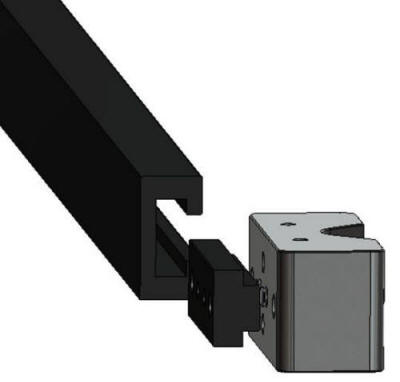
|
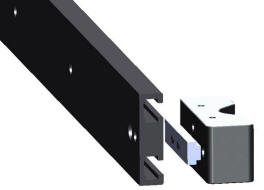
|
| Standard Slide-Track End Section | UniTrack Slide-Track End Section |
| Figure 4 - Slide-Track End Sections | |
The one remaining problem that Mealtime Partners had to solve was how to accommodate both sizes of slide-tracks. To address this need, two different sized T-nuts are available. The smaller T-nut is called the UniTrack T-nut and is to be used on Permobil wheelchair slide-tracks. The larger T-nut is called the Standard T-nut and is designed to accommodate all other types of wheelchair slide-tracks. When ordering drinking or mounting systems for wheelchairs with slide-tracks you will need to specify the type of wheelchair on which it is going to be mounted.
Mealtime Partners has now made all of its drinking and mounting products available for mounting on any wheelchair. For manual wheelchairs, older powered wheelchairs, or metal railed hospital beds, the original wheelchair clamp can be used. The slide-track mounting systems can accommodate all of the newer powered wheelchairs and the hospital bed clamp can mount on several different plastic railed hospital beds. Photographs of our various drinking systems are shown in the advertisement that follows this article.
If you have questions about mounting on a specific wheelchair or bed, please contact us at info@mealtimepartners.com, or call us at 800-996-8607. We are always happy to help!
| A Hands-Free Drinking System to Meet Everyone's Needs | ||||||
|
A hands-free drinking system can enable someone to drink independently throughout the day. Mealtime Partners, Inc. has several different types of hands-free drinking systems to choose from: the Hydration Backpack with Drinking Tube Positioning; the Front Mounted Drinking System; and the Drink Aide. They can all be easily attached to a wheelchair and can be positioned to meet the individual user’s need. |
||||||
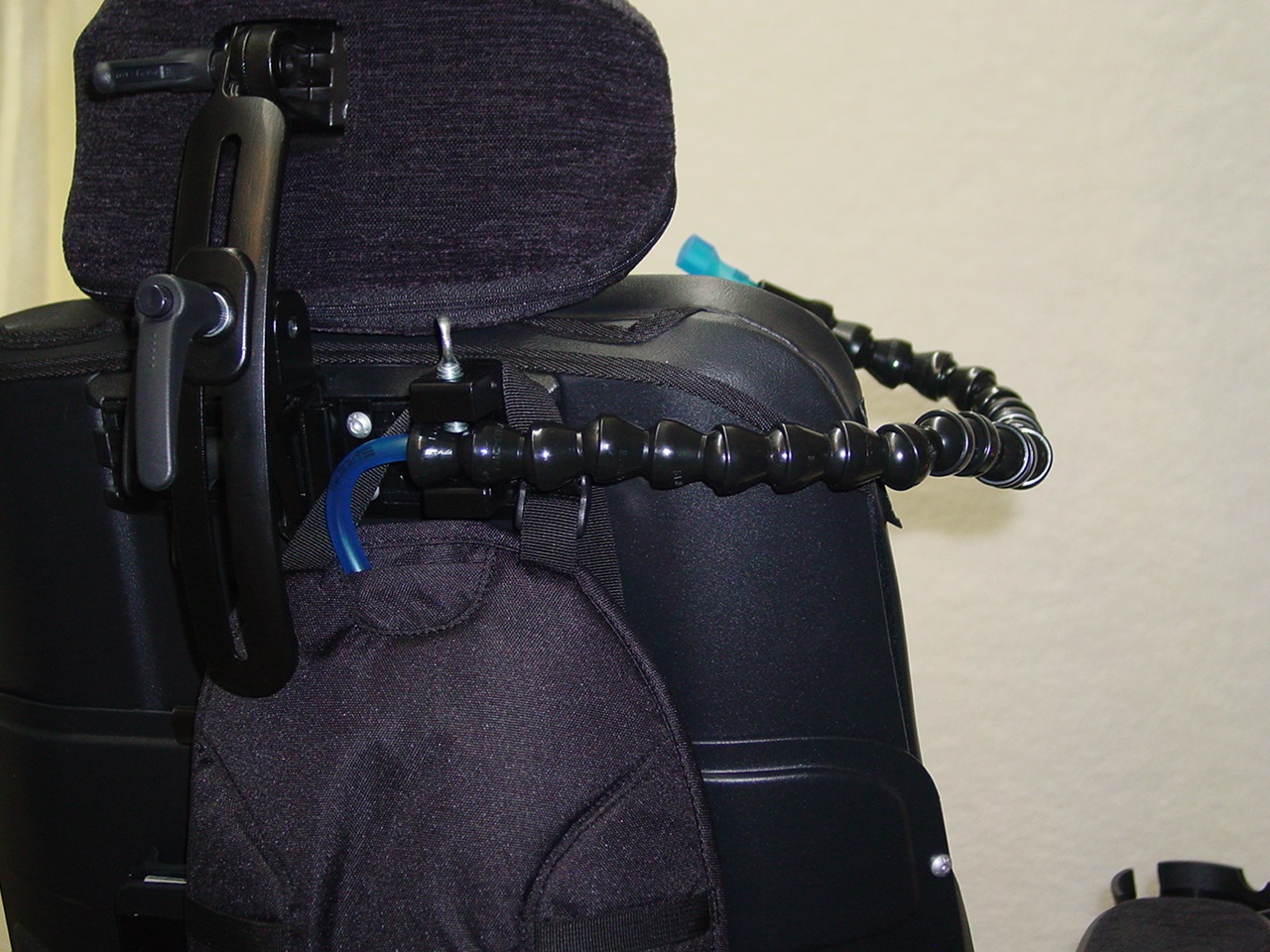
|
||||||
| Hydration Backpack with Drink Tube Positioning | ||||||
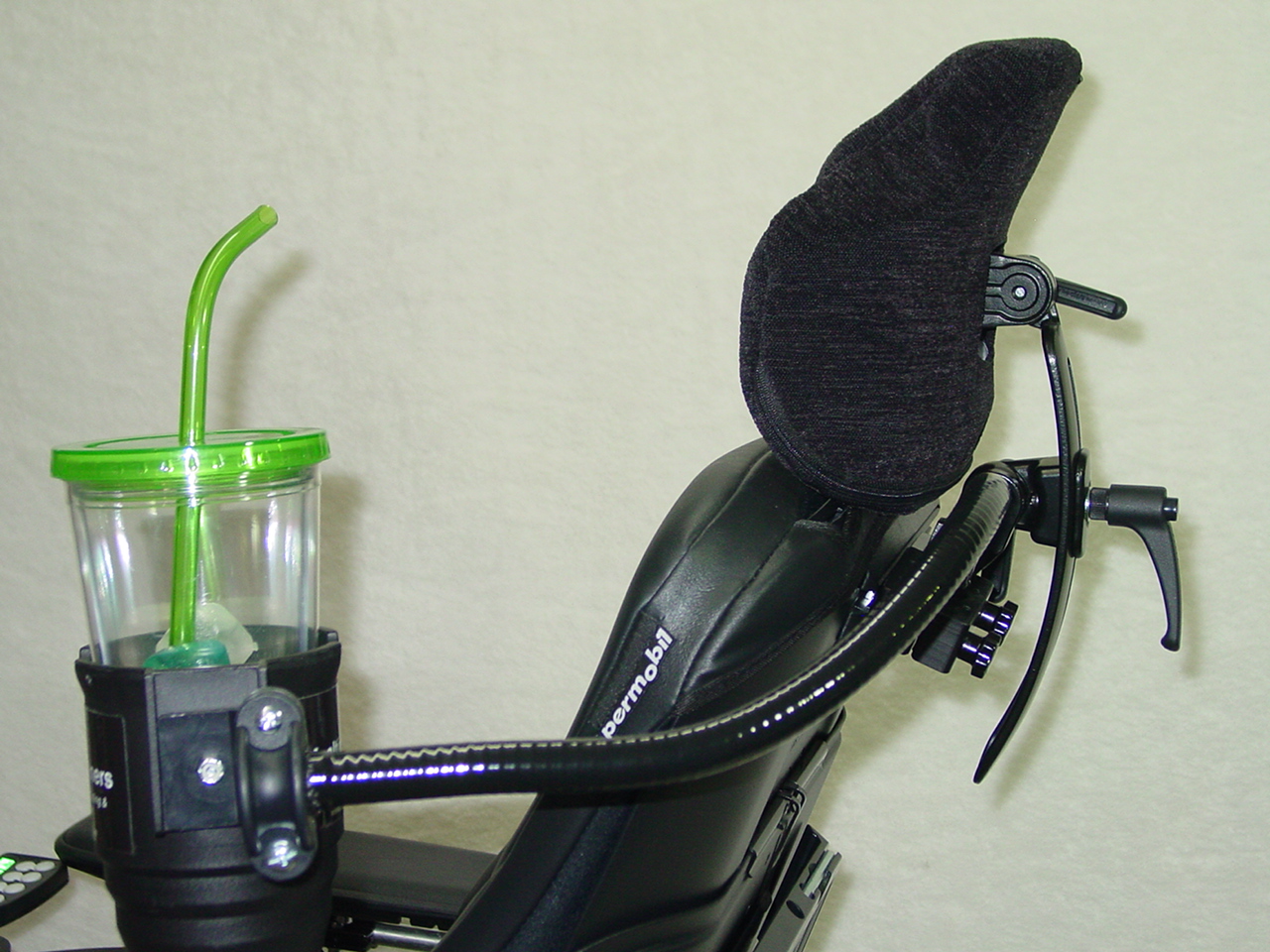 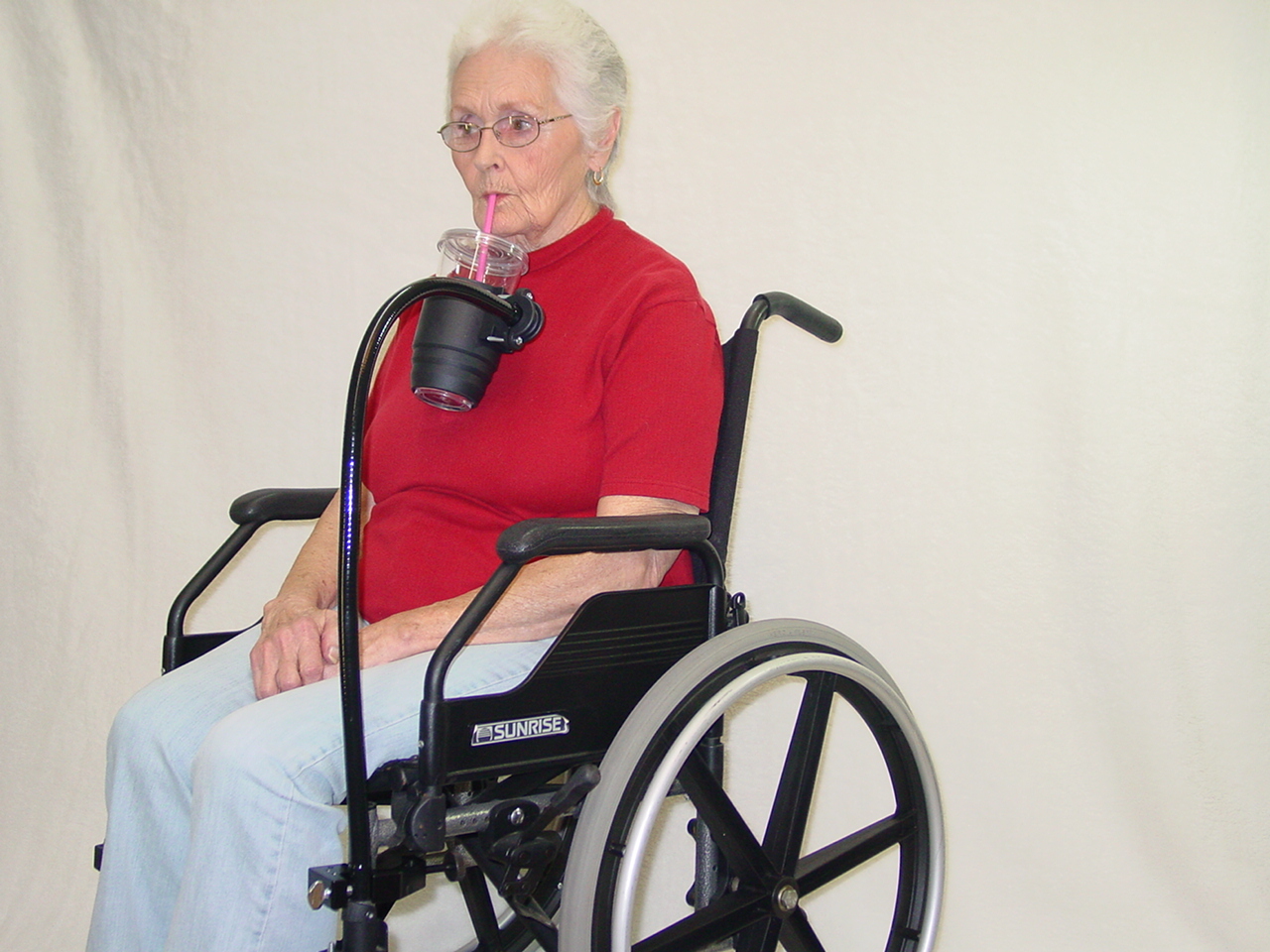 |
||||||
|
Front Mounted Drinking System for Wheelchairs with UniTrack |
Front Mounted Drinking System for Manual Wheelchairs |
|||||
| To view all of the Mealtime Partners drinking products, click here. Remember Mealtime Partners drinking products can be attached to powered wheelchairs with slide-tracks, manual wheelchairs with handles and/or tubular frames, or hospital beds with plastic or metal bed rails. For additional guidance about how to select the appropriate drinking system for your specific needs, click here. | ||||||
Is it a robot? This is one of the questions Mealtime Partners is sometimes asked about the Mealtime Partner Dining System by people who are interested in it. The following article will discuss robots and why powered dining systems can be categorized as robots.
Depending upon which generation you are a part of, your imagination will conjure up different images of what a robot is. Most of what we imagine comes from movies and television. For the over 70 year old set, Robbie the Robot (Forbidden Planet, 1956) might be the first thing you picture. For the next generation, CP30 or R2D2 from Star Wars might come to mind. Early concepts of robots were modeled after people with arms, legs, body and head and were called androids, or humanoid robots. However, the vast majority of robots that are in operation today do not look like people even though many of them have working arms. The word robot comes from the Czech word robota that means “forced work or labor”.
What is a robot? According to WhatIs.com, a robot is a machine designed to execute one or more tasks automatically with speed and precision. But the definition of a robot has become controversial because some people are using the term robot to describe things that do not fit entirely within the older definition of an electro-mechanical machine that is controlled by its integrated electronics and computer programs.
An example of a readily available robot that is in common use is the Roomba. The Roomba is a vacuum cleaner that works independently and is able to vacuum the entire floor on a schedule, or on demand. It is able to clean both carpet and hard surfaces and is able to dock itself to its charging station when its battery is low or when it has completed its cleaning task. The device has motors, sensors and electronic circuits that have a microprocessor that controls the machine using its integrated software.
Robots are used in manufacturing as they are able to conduct repetitive tasks reliably and efficiently. When people conduct the same tasks they become bored and their efficiency can fluctuate. Also, in some manufacturing situations, robots can conduct tasks that are dangerous for people to execute.
With the advances in developing smaller, more capable robots at a lower cost, robots are being integrated into more and more environments. Many machines that were once just machines can now be described as robots, like the vacuum cleaner described earlier. In the world of assistive technology and medical devices this also holds true. However, very few devices that really are robots use the word robot in their name. For example, the da Vinci® Surgical System is a very sophisticated robot that enables surgeons to perform operations through a few small incisions in the patient, rather than the large invasive cuts necessary for traditional surgery. It includes a magnified vision system that gives surgeons a 3-dimensional high-definition view inside the patient’s body; wristed instruments that bend and rotate far more than the human hand, and many other features. In reverse, there are many devices that have robot in their name but they are not necessarily more capable or different from other similar products.
In the early 1990's a device called the Handy 1 was developed in the United Kingdom using an existing 5-axis robot arm. It was the first robot controlled dining device ever made commercially available. Throughout the relatively short history of powered dining equipment, robots have always been seen as the eventual solution to delivering high quality equipment that provides independence in eating to individuals who have limited or no hand and arm function. In 2017 all powered dining devices, available throughout the world, can be described as “robots”.
Yet, even today, with all of the technological advances available, machines that feed people still have shortcomings and don’t necessarily meet all of the mealtime needs or desires of everyone who lacks the ability to eat independently. This can be partially explained by the wide variety of foods eaten and their range of textures. For example, some Asian cultures eat sticky rice with most meals. The texture of the rice makes it very difficult for a feeding device to pick up a single serving without it just being a big clump of rice on a spoon. The same holds true of mashed potatoes eaten in most western cultures. If the potatoes are too thick they will clump on the spoon and be hard, or impossible, to divide into a single serving of an appropriate sized. The list of foods that have dense and/or sticky consistencies is extensive and currently there are no powered dining systems that are able to completely handle this type of food.
However, the Mealtime Partner Dining System has a sophisticated food handling methodology that combines a bowl that is shaped to mate with the spoon, and allow gravity to pull food to the bottom of the bowl; and it has a series of covers that fit on the bowls and control the volume of food on the spoon. This food handling methodology is the most advanced system currently available in feeding devices. It can perform these functions because it is, by definition, a robot. It has a “brain” that interfaces with motors and sensors to facilitate the spoons smart food pick up function. As of now, there are no other feeding robots available that have this advanced food handling capability. The Mealtime Partner cannot only handle standard table food, but is able to serve a range of texture modified foods including pureed food which allows the device to meet the needs of users who have changing needs.
Regardless of how dining equipment is labeled: robot, electro-mechanical device, feeder, etc., dining devices will become more and more capable as technology advances. Hopefully, research will be conducted and better and better equipment will be made available to those who need it. Until that time, the Mealtime Partner remains the only dining system available that has been developed based upon both clinical and engineering research into the development of a safe and effective feeding device.
| Did You Know? Did you know that recent research has found that use of touch screens on a daily basis by infants and toddlers is identified as being associated with reduced sleep and delay of going to sleep? Researchers at the Center for Brain and Cognitive Development, Birkbeck, University of London, found that despite sleep being extremely important for both the brain’s development and cognition, that 20% to 30% of infants and toddlers have problems with sleeping. Heavy use of electronic media including television, mobile phones, video games and tablets by children aged 6 months to 3 years is shown to reduce the total time spent sleeping. Nighttime sleep was reduced with a longer time spent falling asleep, while daytime sleeping was slightly extended. But the overall total daily sleep time was reduced. Because sleep is so important to the development of young brains, the use of electronic devices should be very limited to avoid sleep reduction and/or disruption. |
Mealtime Partners Website Navigation:
Home | Dining | Drinking | Videos | All Products | Warranty | Ordering | Calendar | FAQ | Newsletters | Contact
Please send comments and suggestions to newsletters@mealtimepartners.com
Copyright © Mealtime Partners, Inc. 2017
All rights reserved.